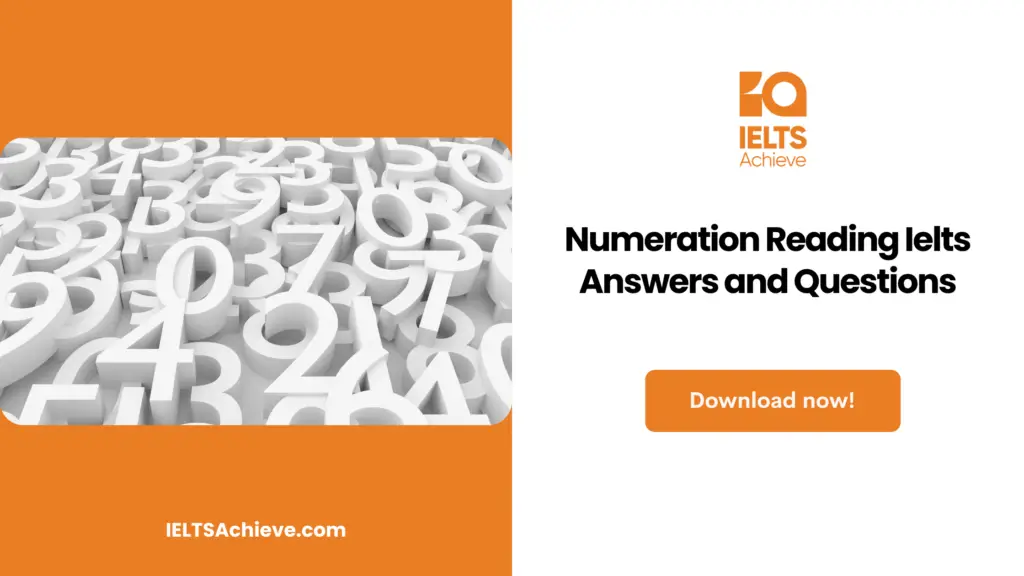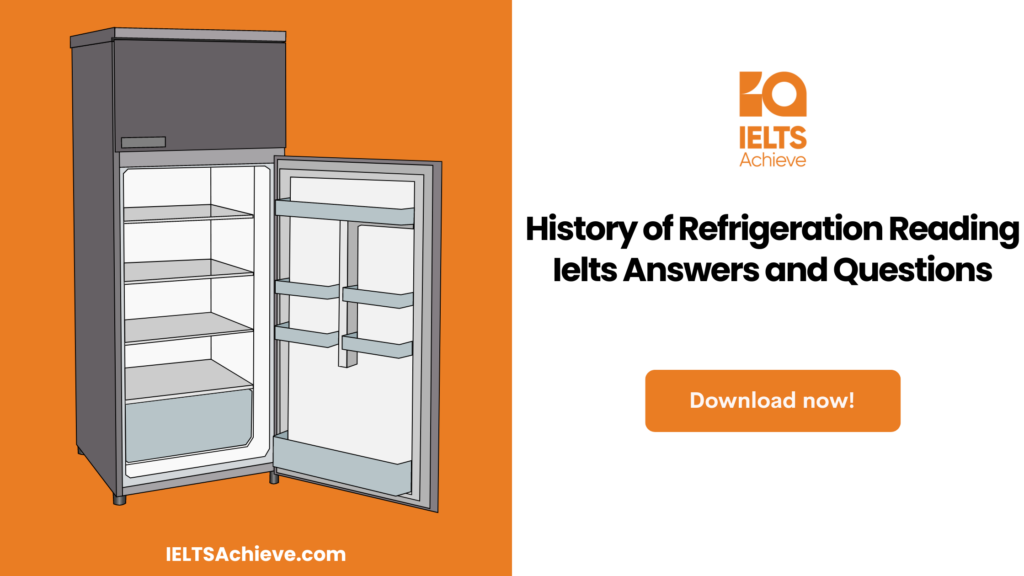The Blog post contains the following IELTS Reading Questions:
- IELTS Reading Summary Completion
- IELTS Reading Matching features
- IELTS Reading True/False/Not Given
Stay informed and prepared for success – Explore our comprehensive Reading Test Info page to get valuable insights, exam format details, and expert tips for mastering the IELTS Reading section.
IELTS Reading Passage – Numeration

Numeration
One of the best intellectual achievements of a baby is learning how to talk to a person, and the next is learning how to count numbers and play with them. From childhood days, we get so attached to the numbers and the numeration system. It is considered a feat of pure imaginative thinking to look at the problems encountered by humans who did not invent this kind of luxury. After a thorough observation of our self-made numeration system, it is clear that it takes us to the conviction that, instead of being a luxury that is inbuilt in a person, it is one of the best and incomparable achievements of the human tribe.
It is not correct to learn the series of things that happened that made us develop the idea of number, number system, etc. Let’s assume that our ancestors developed a system of numeration that, if not advanced, was good enough to perform tasks they had during that time. Our earliest tribal men and women had very limited usage of actual numbers. Is this sufficient? Instead of how many? For instance, when they indulged in hunting and food gathering. On the other hand, when early tribal communities initially started to present on the nature of invariable things surrounded by them, they found out that they required a concept of numbers and number system just to think in an orderly manner. As they started to stop shifting from one place to another, plant trees, and feed animals, the requirement for an advanced number system became inevitable. It will become an unknown fact how and when this numeration skill came to life, however it is clear that certain numeration was developed correctly when we as humans settled for even semi-permanent lives.
There are many proofs and evidence of initial stages of arithmetic and numeration found in some parts of the world. Even now, many tribal people from Tasmania and other parts of Africa were only able to count numbers like one, two, many; in some parts of South Africa counted one, two, two and one, two twos, two twos and one, etc. Now, the number and words are mostly accompanied by physical gestures to avoid unnecessary confusion. For instance, while counting the numbers like one, two, many types of system, the word many would seem to be, Follow my hands and follow the number of fingers I am showing you. This fundamental step is used only in the variety of numbers which it can express, but this will normally diminish while facing the easier components of mere existence.
The deprivation of skills of some ethnicity to face large numbers is not astonishing. When we look back to the earlier version of European languages, it is found that the words, expressions and numbers are very poor in standards. In the ancient Gothic word, the word for teon, tachund tachund, was represented as the number 100 as tachund tachund. Similarly, in the seventh century, the word toen was interchangeable with the tachund or hund of the Anglo-Saxon language, and so 100 was denoted as hund teontig, or ten times ten. A typical individual from the seventh century in Europe did not know anything about numbers as we use them in this modern era. In the previous days, when a person needed to be produced as a witness in a court of law, they must be able to count numbers from one to nine.
In this case the most basic action to develop a sense of number is definitely not how to count but rather to understand that the concept of number is an abstract idea. It is not a simple attachment to a group of specific subjects. The earliest human race must have been able to predict and understand that four birds are different from two birds. But, it is not that basic to count the number 4, as it is associated with four birds, to the number 4, as it is associated with four rocks. Connecting to a number as one of the qualities of a specific object causes great difficulty to the imagination and development of a true number system. If the number 4 is able to register in the mind in terms of a specific word, then the person can easily take the next step to develop a notational system for numbers. Once that is done, they can shift to arithmetic concepts.
There are many traces identified in the early stages of the development of numeration. It can be witnessed in many currently speaking languages. In British Columbia, the Tsimshian language has approximately seven different forms of words, especially for numbers based on the class of the item counted. For example, to count flat objects, materials and animals, to count round objects, time, to count the number of people, to count the long objects like trees, to count canoes, to measure something, and to count any particular item which is not being numerated. It is found that the last was a new development from the humans’ side, where the first six groups reveal the order system used. When we look at the Japanese language, we can find this diversity of names for each number.
Interconnected with the number sense development is nothing but the development of a skill to count. Here, the process of counting is not directly associated with the information of a number concept mainly because it is fine to do counting by comparing the items that are counted against a set of pebble stones, corn grains, or the fingers. These support systems might be inevitable to the ancient society, who might have considered this process impossible. This does not require any mechanical support as well. These support systems, though they are different, are in use by literate people as it seems to be convenient. It is very clear that whatever is counted obviously refers to something other than the object that counted. Previously, it was seen as grains, pebbles, etc. Now it is a memorised series of words that are assigned to each number counted.
Unlock your full potential in the IELTS Reading section – Visit our IELTS Reading Practice Question Answer page now!
Recommended Questions:
Renewable Energy IELTS Reading Question with Answer
Numeration Reading Questions
Questions 1 – 7
Complete the summary below.
Choose NO MORE THAN TWO WORDS AND/OR A NUMBER from the passage for each answer.
Similarly, in the seventh century, the word 1. ________ was interchangeable with the tachund or 2. _________ of the Anglo-Saxon language, and so 100 was denoted as hund teontig, or ten times ten. A typical individual from the 3. __________ in Europe did not know anything about numbers as we use them in this modern era. In the previous days, when a person needed to be produced as a 4. ___________ in a court of law, they must be able to 5. __________ numbers from one to nine. In this case the most basic action to develop a sense of number is definitely not how to count but rather to 6. ___________ that the concept of number is an 7. ___________. It is not a simple attachment to a group of specific subjects.
Boost your performance in Summary, Notes, Table, and Flowchart Completion tasks. Click here to explore our detailed guide and learn how to effectively complete summaries, notes, tables, and flowcharts in the IELTS Reading section.
Questions 8 – 10
Match the correct statement with the letter
8. Our earliest tribal men and women had
9. The earlier version of European languages had poor standards in
10. Self-made numeration system is a
- Numbers, words, and expressions
- Extraordinary achievement
- minimum use of actual numbers
Improve your performance in Matching Features questions by clicking here to access our comprehensive guide. Learn how to match specific features or characteristics with the options provided in the IELTS Reading section.
Questions 11 – 13
Do the following statements agree with the information given in the reading passage?
Write
TRUE, if the statement agrees with the information
FALSE, if the statement contradicts the information
NOT GIVEN, if there is no information on this in the passage
11. The Tsimshian language in British Columbia has more letters than other languages
12. A person from Europe during the seventh century knows something about numbers
13. In the Anglo-Saxon language, the word toen was interchangeable with tachund
Enhance your skills in identifying information as True, False, or Not Given. Click here to discover expert strategies and techniques for mastering this question type in the IELTS Reading section.
Unlock your full potential in the IELTS Reading section – Visit our IELTS Reading Practice Question Answer page now!
Recommended Questions:
Renewable Energy IELTS Reading Question with Answer
Numeration Reading Answers
1. Toen
2. Hund
3. Seventh century
4. Witness
5. Count
6. Understand
7. Abstract idea
8. C
7. A
8. B
9. Not Given
10. False
11. True

We hope you found this post useful in helping you to study for the IELTS Test. If you have any questions please let us know in the comments below or on the Facebook page.
The best way to keep up to date with posts like this is to like us on Facebook, then follow us on Instagram and Pinterest. If you need help preparing for the IELTS Test, join the IELTS Achieve Academy and see how we can assist you to achieve your desired band score. We offer an essay correction service, mock exams and online courses.

